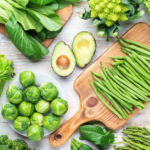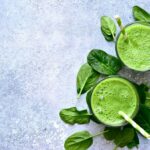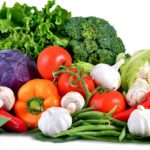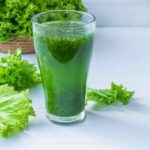In this blog, we will explore a variety of what food helps you lose belly fat. From nutrient-rich fruits and vegetables to lean protein sources and healthy fats, we’ll provide you with a comprehensive guide to help trim your waistline.
Whether you’re looking to shed a few inches or maintain a flat tummy, incorporating these belly fat-busting foods into your diet can make a significant difference in achieving your goals. Give your extra belly fat the boot and welcome a healthier, happier self!
The challenge of belly fat

Excess belly fat is a common concern for many individuals, and it poses unique challenges on the path to achieving a healthy and fit body. This chapter will delve into the various aspects of the challenge posed by belly fat, including its impact on physical health, self-esteem, and overall well-being.
The Health Risks Associated with Belly Fat:
Carrying excess fat around the waistline, specifically in the abdominal area, can have significant health implications. Research has consistently linked belly fat, particularly visceral fat, with an increased risk of various health conditions, such as:
Cardiovascular Diseases:
Visceral fat, which surrounds vital organs like the heart and liver, releases inflammatory substances that can contribute to the development of heart disease, high blood pressure, and elevated cholesterol levels. The risk of heart attacks, strokes, and other cardiovascular problems is considerably increased by these factors.
Type 2 Diabetes:
Belly fat is closely associated with insulin resistance and impaired glucose metabolism. The accumulation of visceral fat increases the risk of developing type 2 diabetes, as it disrupts insulin production and utilization in the body.
Metabolic Syndrome:
Belly fat is a key component of metabolic syndrome, a cluster of conditions that includes high blood pressure, high blood sugar, abnormal cholesterol levels, and excess abdominal fat. Diabetes, heart disease, and stroke are all significantly more risk factors for metabolic syndrome.
Value of a balanced diet in reducing abdominal fat

When it comes to shedding belly fat and achieving a toned midsection, a healthy diet plays a crucial role. This chapter will highlight the significance of adopting a nutritious eating plan in the pursuit of losing belly fat effectively and sustainably.
Calorie Balance and Fat Loss:
A healthy diet helps create a calorie deficit, which is essential for fat loss. Consuming fewer calories than you burn prompts your body to tap into stored fat reserves, including belly fat, for energy. By focusing on nutrient-dense, low-calorie foods, you can create a sustainable calorie balance and support fat loss.
Reduced Consumption Of Processed Foods:
A key component of a healthy diet for losing belly fat is reducing or eliminating processed foods. These items often contain high levels of added sugars, unhealthy fats, and empty calories. By cutting back on processed foods and opting for whole, unprocessed foods, you provide your body with vital nutrients while avoiding excess calories and harmful ingredients.
Increased Nutrient Intake:
Consuming nutrient-dense foods including fruits, vegetables, whole grains, lean meats, and healthy fats is emphasized in a healthy diet. These foods provide essential vitamins, minerals, antioxidants, and fiber, which support overall health and facilitate weight loss. Nutrient-dense foods help you stay satiated, manage cravings, and maintain energy levels while reducing belly fat.
Controlling Blood Sugar Levels:
Dietary choices significantly influence blood sugar levels, and controlling them is essential for losing belly fat. Consuming foods with a low glycemic index, such as whole grains, legumes, and non-starchy vegetables, helps regulate blood sugar and insulin levels. Stable blood sugar levels reduce the likelihood of excess fat storage, particularly in the abdominal area.
Promoting Healthy Gut Bacteria:
Research suggests a link between the composition of gut bacteria and body weight regulation. A healthy diet that includes fiber-rich foods, probiotics, and prebiotics can promote a diverse and beneficial gut microbiome. A balanced gut microbiome contributes to improved digestion, better nutrient absorption, and reduced inflammation, all of which aid in weight management and belly fat reduction.
Fiber-Rich Foods

Fiber is a key component of a healthy diet, and incorporating fiber-rich foods can greatly contribute to losing belly fat. This chapter will highlight the importance of dietary fiber and provide a list of fiber-rich foods that can aid in achieving a trimmer waistline.
Fiber’s Function in Belly Fat Loss
Dietary fiber offers numerous benefits for weight management, including the reduction of belly fat. Here’s how fiber works:
Increased Satiety:
Fiber-rich foods tend to be more filling and provide a greater sense of satiety compared to low-fiber foods. By consuming fiber-rich meals and snacks, you can feel satisfied for longer periods, reducing the likelihood of overeating and snacking on calorie-dense foods.
Slower Digestion and Blood Sugar Regulation:
Fibre slows down the digestive process, causing glucose to enter the system more gradually. This helps prevent rapid spikes in blood sugar levels, which can contribute to fat storage, particularly in the abdominal area.
Reduced Caloric Density:
Fiber-rich foods are often low in calories but high in volume. This means you can consume larger portions while keeping calorie intake in check. By incorporating fiber-rich foods into your meals, you can create a more balanced and satisfying diet while promoting belly fat loss.
Fiber-Rich Foods To Include In Your Diet:
Here are some excellent sources of dietary fiber that can aid in losing belly fat:
Fruits:
Apples
Banana
Berries (raspberries, blueberries, strawberries)
Oranges
Pears
Avocados
Vegetables:
Leafy greens (spinach, kale, collard greens)
Broccoli
Brussels sprouts
Carrots
Bell peppers
Legumes:
Lentils
Chickpeas
Black beans
Kidney beans
Split peas
Whole Grains:
Oats
Quinoa
Brown rice
Whole wheat bread
Barley
Nuts and Seeds:
Almonds
Chia seeds
Flaxseeds
Pistachios
Walnuts
Lean Protein Sources

Including lean protein sources in your diet is essential for losing belly fat and achieving a toned midsection. This chapter will highlight the importance of lean proteins, and their role in weight loss, and provide a list of protein-rich foods that can aid in reducing belly fat.
The Role of Lean Protein in Belly Fat Loss:
Lean proteins offer several benefits when it comes to weight management and belly fat reduction. Here’s how they contribute to your goals:
Increased Satiety:
Protein-rich foods are known to be highly satiating. Including adequate protein in your meals and snacks helps you feel full and satisfied, reducing the likelihood of overeating or reaching for unhealthy snacks.
Muscle Maintenance and Development:
Protein plays a vital role in preserving and building lean muscle mass. When combined with regular exercise, lean protein sources help maintain muscle tissue, which can enhance your metabolic rate and promote fat burning, including belly fat.
Thermic Effect of Food:
The thermic effect of food refers to the energy expenditure required to digest, absorb, and process nutrients. Protein has a higher thermic effect compared to carbohydrates and fats, meaning that your body burns more calories during the digestion and metabolism of protein-rich foods.
Stable Blood Sugar Levels:
Including protein in your meals helps slow down the digestion and absorption of carbohydrates, leading to a more gradual release of glucose into the bloodstream. This helps stabilize blood sugar levels, reducing the likelihood of excess fat storage, particularly in the abdominal area.
Lean protein sources to include in your diet:
Here are some excellent sources of lean protein that can aid in losing belly fat:
Poultry:
Chicken breast
Turkey breast
Lean ground turkey
Eggs
Fish and Seafood:
Salmon
Tuna
Cod
Shrimp
Tilapia
Lean Meats:
Beef cuts that are lean, such sirloin or tenderloin
Pork tenderloin
Bison
Venison
Plant-Based Proteins:
Tofu
Tempeh
Lentils
Chickpeas
Quinoa
Dairy and Dairy Alternatives:
Greek yogurt (low-fat or non-fat)
Cottage cheese (low-fat or non-fat)
Almond milk (unsweetened)
Soy milk (unsweetened)
Healthy Fats

Contrary to popular belief, not all fats are bad for you. In fact, healthy fats play a crucial role in a balanced diet and can contribute to losing belly fat. This chapter will highlight the importance of incorporating healthy fats, and their benefits, and provide a list of sources to aid in achieving a trimmer waistline.
Understanding Healthy Fats:
Healthy fats, also known as unsaturated fats, are an essential part of a nutritious diet. They provide a range of benefits for overall health and weight management. Healthy fats are primarily classified into two categories:
Monounsaturated Fats:
Monounsaturated fats are known to improve heart health, reduce inflammation, and support weight loss efforts. They can help decrease belly fat by influencing insulin sensitivity and promoting a feeling of fullness.
Polyunsaturated Fats:
Polyunsaturated fats, particularly omega-3 fatty acids, have been associated with various health benefits, including reduced inflammation, improved brain function, and enhanced fat metabolism. Omega-3 fatty acids may also target belly fat by reducing fat storage and promoting fat burning.
Benefits of Healthy Fats for Belly Fat Loss:
Including healthy fats in your diet offers several advantages when it comes to losing belly fat:
Increased Satiety:
Healthy fats are digested slowly, promoting a feeling of fullness and reducing cravings. By incorporating healthy fats into your meals, you can stay satisfied for longer and avoid overeating.
Nutrient Absorption:
Vitamins A, D, E, and K are examples of fat-soluble vitamins, meaning they need fat to be well absorbed. Including healthy fats in your meals helps ensure the efficient absorption of these essential nutrients.
Hormone Regulation:
Healthy fats play a role in hormone production and regulation. Hormones influence various aspects of metabolism, including fat storage and utilization. By consuming adequate healthy fats, you can support optimal hormonal balance and potentially reduce belly fat accumulation.
Anti-Inflammatory Effects:
Chronic inflammation can contribute to weight gain and an increased risk of metabolic disorders. Healthy fats, particularly omega-3 fatty acids, possess anti-inflammatory properties, which can help reduce inflammation in the body and potentially impact belly fat.
Add these beneficial sources of fat to your diet:
Here are some excellent sources of healthy fats that can aid in losing belly fat:
Avocados:
Avocados include a lot of fiber, monounsaturated fats, and several vitamins and minerals. They can be enjoyed sliced, mashed, or as an ingredient in dips and salads.
Olive Oil:
Extra virgin olive oil is a staple of the Mediterranean diet and is rich in monounsaturated fats. It can be used for cooking, salad dressings, or as a drizzle over cooked dishes.
Nuts and Seeds:
Healthy fats are abundant in almonds, walnuts, chia seeds, flaxseeds, and hemp seeds. Enjoy them as snacks, sprinkle them over salads, or incorporate them into your smoothies.
Fatty Fish:
Omega-3 fatty acids are found in fatty fish including trout, salmon, mackerel, and sardines. Aim to consume fatty fish a couple of times per week.
Nut Butter:
Natural nut butter, such as almond butter or peanut butter, can be a nutritious and tasty addition to your meals or snacks. Look for options without added sugars or unhealthy oils.
Thermogenic Foods

Thermogenic foods are known for their ability to increase metabolism and promote fat burning. Incorporating these foods into your diet can aid in losing belly fat and achieving a toned midsection. This chapter will highlight the concept of thermogenesis, and its impact on weight loss, and provide a list of thermogenic foods to support your goals.
Understanding Thermogenesis:
Thermogenesis refers to the process by which your body generates heat and burns calories to digest and metabolize food. Certain foods have a thermogenic effect, meaning they require more energy to be digested, resulting in a temporary increase in metabolism. This increase in metabolic rate can contribute to fat burning and weight loss, including belly fat reduction.
Benefits of Thermogenic Foods for Belly Fat Loss:
Incorporating thermogenic foods into your diet offers several advantages when it comes to losing belly fat:
Increased Calorie Expenditure:
Thermogenic foods require more energy for digestion, leading to a higher calorie burn. This can contribute to creating a calorie deficit and promoting fat loss, including belly fat.
Enhanced Fat Oxidation:
Thermogenic foods can stimulate the oxidation of stored fat. By consuming these foods, you may encourage your body to utilize fat as an energy source, particularly in the abdominal area.
Appetite Control:
Some thermogenic foods have appetite-suppressing properties, helping to reduce cravings and calorie intake. This can support weight management and facilitate belly fat loss.
Thermogenic Foods to Include in Your Diet:
Here are some excellent thermogenic foods that can aid in losing belly fat:
Green Tea:
Green tea contains catechins, which have been shown to increase metabolism and promote fat oxidation. Enjoy a cup of green tea as a refreshing and thermogenic beverage.
Chili Peppers:
Capsaicin, the compound responsible for the heat in chili peppers, can boost metabolism and increase fat burning. Add some spice to your meals by incorporating chili peppers or hot sauce.
Ginger:
Ginger has thermogenic properties and can help increase calorie expenditure. Use fresh or powdered ginger in your cooking or enjoy it in herbal tea.
Caffeine:
Caffeine is a natural stimulant that can temporarily boost metabolism and enhance fat burning. Enjoy a cup of coffee or tea (in moderation) to reap its thermogenic benefits.
Whole Grains:
Whole grains, such as oats, quinoa, and brown rice, have a higher thermic effect compared to processed grains. They require more energy to digest, leading to increased calorie expenditure.
Protein-Rich Foods:
Protein-rich foods, including lean meats, poultry, fish, legumes, and Greek yogurt, have a higher thermic effect compared to fats and carbohydrates. Incorporating protein into your meals can aid in increasing metabolism and promoting fat burning.
Water-Rich Foods

Staying hydrated is crucial for overall health and weight management, including losing belly fat. Water-rich foods can help you meet your hydration needs while providing essential nutrients and supporting satiety. This chapter will highlight the importance of water-rich foods, and their benefits, and provide a list of hydrating options to aid in achieving a trimmer waistline.
The Significance of Hydration for Belly Fat Loss:
Proper hydration is essential for optimal bodily functions and plays a role in weight management. When it comes to losing belly fat, staying hydrated offers several advantages:
Enhanced Metabolism:
Water is involved in various metabolic processes, including fat metabolism. Staying hydrated can support your metabolism, ensuring efficient calorie burning and potentially aiding in belly fat loss.
Appetite Control:
Drinking water and consuming water-rich foods can help promote feelings of fullness, reducing the likelihood of overeating and snacking on calorie-dense foods. Adequate hydration can contribute to appetite control and weight management.
Improved Digestion:
Proper hydration supports healthy digestion by facilitating the breakdown and absorption of nutrients. This can optimize your body’s ability to utilize nutrients efficiently and potentially impact belly fat accumulation.
Benefits of Water-Rich Foods for Belly Fat Loss:
Hydration:
Water-rich foods naturally contain a high percentage of water, helping you stay hydrated throughout the day. Adequate hydration supports optimal bodily functions and can contribute to overall weight management.
Nutrient Density:
Water-rich foods are often rich in essential vitamins, minerals, and fiber. By consuming these foods, you provide your body with vital nutrients while keeping calorie intake in check.
Satiety:
Water-rich foods tend to be low in calories but high in volume, which means you can consume more substantial portions without consuming excess calories. This can contribute to a feeling of fullness and satiety while supporting weight loss efforts.
Healthy Snacking:
Water-rich foods make for excellent snack options, providing a refreshing and hydrating alternative to calorie-dense snacks. Incorporating these foods into your snacking routine can help curb cravings and reduce overall calorie intake.
Water-Rich Foods to Include in Your Diet:
Here are some excellent water-rich foods that can aid in losing belly fat:
Cucumber:
Cucumbers are composed mainly of water and provide hydration along with essential vitamins and minerals. Take pleasure in them as a cooling snack or cut in salads.
Watermelon:
Watermelon is not only hydrating but also delicious. Its high water content makes it a perfect summer fruit that can aid in satisfying your sweet tooth while keeping you hydrated.
Citrus Fruits:
Citrus fruits like oranges, grapefruits, and lemons have high water content and are rich in vitamin C. They make for hydrating snacks or can be added to salads and infused with water for extra flavor.
Leafy Greens:
Leafy greens such as lettuce, spinach, and kale have high water content and are packed with essential nutrients. Include them in salads, or smoothies, or sauté them as a healthy side dish.
Berries:
Berries like strawberries, raspberries, and blueberries are not only hydrating but also rich in antioxidants and fiber. Enjoy them as a snack, in smoothies, or as toppings for yogurt or oatmeal.
Foods to Avoid

While incorporating healthy and nutritious foods is crucial for losing belly fat, it’s equally important to be mindful of the foods that can hinder your progress. This chapter will highlight the foods that are best avoided when aiming to achieve a trimmer waistline. By eliminating or minimizing these foods, you can optimize your weight loss efforts and improve overall health.
Understanding the Impact of Unhealthy Foods:
Certain foods can contribute to weight gain, promote inflammation, and lead to an accumulation of belly fat. By avoiding these foods, you can create a healthier environment for your body to burn fat and achieve your goals.
Foods to Limit or Avoid for Belly Fat Loss:
The following are some foods that are best avoided or limited when aiming to lose belly fat:
Sugary Beverages:
Sugar-sweetened beverages like soda, fruit juices, energy drinks, and sweetened coffees are high in added sugars and empty calories. These beverages can lead to weight gain and an increase in visceral fat. Instead, choose unsweetened beverages, water, or herbal tea.
Processed Foods:
Processed foods, including packaged snacks, chips, cookies, and fast food, are often high in unhealthy fats, added sugars, and refined carbohydrates. These foods are typically calorie-dense and low in nutrients, making them detrimental to weight loss efforts. Choose whole, unprocessed foods whenever possible.
Trans Fats:
Trans fats, often found in fried foods, margarine, and commercially baked goods, are highly unhealthy fats that contribute to inflammation and weight gain. Check food labels and avoid products that contain hydrogenated or partially hydrogenated oils.
Refined Grains:
Refined grains like white bread, white rice, and refined pasta lack fiber and essential nutrients. They can cause spikes in blood sugar levels, leading to increased fat storage, especially in the abdominal area. Choose whole grains like brown rice, whole grain pasta, and whole wheat bread.
Excessive Alcohol:
Alcohol is high in calories and can contribute to weight gain, especially when consumed in excess. It also impairs metabolism and inhibits fat burning. Limit your alcohol intake and opt for healthier alternatives like herbal tea or infused water.
High-Sodium Foods:
Foods high in sodium, such as processed meats, canned soups, and fast food, can cause water retention and bloating, giving the appearance of a larger waistline. Opt for fresh, homemade meals with minimal added salt and choose low-sodium options when available.
Sweetened Snacks and Desserts:
Snacks and desserts that are high in added sugars, such as candy, pastries, and ice cream, provide little nutritional value and can lead to weight gain. Instead, satisfy your sweet tooth with naturally sweet fruits or homemade treats using healthier alternatives like dates or stevia.
Meal Planning Tips

Effective meal planning is a key component of achieving belly fat loss and maintaining a healthy lifestyle. By thoughtfully organizing your meals and snacks, you can ensure balanced nutrition, portion control, and adherence to your weight loss goals. This chapter will provide valuable meal planning tips to support your journey towards a trimmer waistline.
Importance of Meal Planning for Belly Fat Loss:
Meal planning offers numerous benefits when it comes to losing belly fat:
Portion Control:
By planning your meals in advance, you can control portion sizes and avoid overeating. This promotes a calorie deficit, which is crucial for weight loss.
Balanced Nutrition:
Meal planning allows you to ensure that your meals are nutritionally balanced, incorporating lean proteins, complex carbohydrates, healthy fats, and a variety of fruits and vegetables. This provides essential nutrients while supporting satiety and energy levels.
Reduced Impulsive Choices:
Having pre-planned meals and snacks helps you resist the temptation of unhealthy options or impulsive food choices. It promotes mindful eating and reduces the likelihood of reaching for calorie-dense, belly fat-inducing foods.
Time and Cost Savings:
Meal planning can save you time and money by minimizing last-minute grocery store visits and reducing food waste. It also enables you to prepare meals in bulk, ensuring you have healthy options readily available throughout the week.
Meal Planning Tips for Belly Fat Loss:
Consider the following tips to optimize your meal-planning efforts:
Set Realistic Goals:
Define your belly fat loss goals and establish a realistic calorie intake based on your activity level, age, and gender. For individualised advice, speak with a licenced dietician or healthcare provider.
Plan Meals in Advance:
Take time each week to plan your meals and snacks. Create a menu for breakfast, lunch, dinner, and snacks, considering nutritional balance and variety. Aim for a mix of lean proteins, whole grains, fruits, vegetables, and healthy fats.
Prep and Cook in Bulk:
Allocate a specific day or time to prepare and cook larger quantities of food. This way, you can have pre-portioned meals and ingredients ready to go throughout the week. Use portion control containers or meal prep containers for convenience.
Prioritize Whole, Unprocessed Foods:
Include whole, unprocessed foods as the foundation of your meals. Focus on lean proteins such as chicken, turkey, fish, legumes, and tofu. Incorporate complex carbohydrates like quinoa, brown rice, whole wheat bread, and sweet potatoes. Fill half of your plate with a variety of vegetables and include healthy fats like avocado, nuts, and olive oil.
Incorporate Fiber:
Choose high-fiber foods like fruits, vegetables, whole grains, and legumes. Fiber promotes satiety, aids in digestion, and can help reduce belly fat accumulation.
Plan for Healthy Snacks:
Include nutritious snacks in your meal plan to avoid reaching for unhealthy options. Opt for options such as Greek yogurt, mixed nuts, cut vegetables with hummus, or fruit.
Stay Hydrated:
Don’t forget to include hydration in your meal plan. Make an effort to get enough water throughout the day. You can also infuse water with fruits or herbs to add flavor.
Be Flexible:
While it’s essential to have a meal plan, allow for flexibility. Be open to adapting the plan based on your preferences, seasonal availability of ingredients, and unforeseen circumstances.
Exercise and Lifestyle Factors

In addition to a healthy diet, incorporating regular exercise and adopting certain lifestyle habits are essential for losing belly fat and achieving a trimmer waistline. This chapter will explore the importance of exercise and lifestyle factors in belly fat loss and provide practical tips to help you make sustainable changes.
Exercise for Belly Fat Loss:
Exercise plays a significant role in burning calories, boosting metabolism, and promoting overall fat loss, including belly fat. Incorporating both cardiovascular exercise and strength training can be effective in achieving your goals.
Cardiovascular Exercise:
Engaging in cardiovascular exercises, such as brisk walking, jogging, cycling, swimming, or aerobic workouts, helps burn calories and increase heart rate. Aim for 75 minutes of strenuous activity or 150 minutes of cardio at a moderate intensity per week.
High-Intensity Interval Training (HIIT):
HIIT workouts involve alternating between short bursts of high-intensity exercise and active recovery periods. This type of training has been shown to be effective in reducing belly fat and improving overall body composition. Incorporate HIIT workouts 1-2 times per week alongside your regular cardio routine.
Strength Training:
Strength training helps build lean muscle mass, which increases metabolism and promotes fat burning. Include exercises that target the major muscle groups, such as squats, lunges, deadlifts, push-ups, and planks. Aim for 2-3 strength training sessions per week.
Core Exercises:
Including exercises that specifically target the core muscles can help strengthen and tone the abdominal area. Planks, crunches, Russian twists, and bicycle crunches are effective exercises to incorporate into your routine.
Lifestyle Factors for Belly Fat Loss:
Certain lifestyle habits can contribute to belly fat accumulation. By adopting healthier practices, you can support your weight loss journey and achieve a trimmer waistline.
Get Sufficient Sleep:
For weight management and overall health, getting enough sleep is essential. Lack of sleep disrupts hormonal balance, increases appetite, and promotes weight gain, including belly fat. Spend 7-9 hours each night getting a good night’s sleep.
Manage Stress:
A hormone linked to increased belly fat, cortisol, is released as a result of ongoing stress. Reduce stress levels by incorporating stress-reduction strategies including yoga, deep breathing exercises, meditation, or indulging in hobbies.
Stay Hydrated:
Proper hydration supports optimal metabolism and digestion, which can aid in belly fat loss. Limit sugary beverages and drink enough water throughout the day.
Limit Alcohol Consumption:
Alcohol has a lot of calories and can make you gain belly fat. To help you reach your weight loss objectives, cut back on or completely avoid alcohol consumption.
Practice Mindful Eating:
Be mindful of your eating habits by paying attention to portion sizes, eating slowly, and listening to your body’s hunger and fullness cues. Refrain from using electronic devices or watching TV while you’re eating.
Stay Consistent:
Consistency is key in achieving belly fat loss. Make exercise and healthy eating a regular part of your lifestyle rather than relying on short-term solutions. Set realistic goals and create a routine that you can stick to in the long term.
Seek Professional Guidance:
If you are new to exercise or have any underlying health concerns, it’s advisable to consult a healthcare professional or a certified fitness trainer. They can provide personalized guidance, create an appropriate exercise program, and monitor your progress.
Frequently Asked Questions
Q: When will I start to shed my tummy fat?
A: The time it takes to lose belly fat can vary depending on various factors such as your starting weight, body composition, genetics, diet, and exercise routine. It’s important to focus on sustainable and healthy weight loss, aiming for a gradual loss of 1-2 pounds per week. With consistent effort and a balanced approach, you can start seeing noticeable changes in your belly fat within a few weeks to a few months.
Q: Can I spot-reduce belly fat?
A: Spot reduction, or targeting fat loss from a specific area, is a common misconception. Unfortunately, it’s not possible to exclusively lose fat from the belly alone through targeted exercises or specific foods. Fat loss occurs throughout the body as a whole, and genetics play a role in determining where your body loses fat first. However, adopting a comprehensive approach that includes a healthy diet, regular exercise, and overall fat loss can help reduce belly fat over time.
Q: What are some effective exercises to target belly fat?
A3: While you cannot spot-reduce belly fat, engaging in exercises that target the abdominal muscles can help strengthen and tone the area. Effective exercises include planks, crunches, Russian twists, bicycle crunches, and leg raises. However, it’s important to remember that these exercises alone will not make your belly fat disappear. They should be combined with a balanced diet and overall fat loss strategies for the best results.
Q: Are there any specific foods that help reduce belly fat?
A4: No specific food can directly target belly fat. However, incorporating a balanced diet that includes whole, unprocessed foods, lean proteins, healthy fats, fiber-rich fruits and vegetables, and complex carbohydrates can support overall weight loss and belly fat reduction. It’s important to create a calorie deficit by consuming fewer calories than you burn through a combination of diet and exercise.
Q: How important is hydration for losing belly fat?
A: Staying hydrated is crucial for overall health and weight management, including losing belly fat. Proper hydration supports metabolism, digestion, and appetite control. Drinking water and consuming water-rich foods can help promote feelings of fullness, reduce calorie intake, and optimize bodily functions. Aim to drink an adequate amount of water throughout the day and incorporate hydrating foods like cucumbers, watermelon, and citrus fruits into your diet.
Q: Is it necessary to completely avoid all fats for belly fat loss?
A: No, it is not necessary to completely avoid all fats for belly fat loss. Healthy fats, such as monounsaturated fats found in avocados, nuts, and olive oil, and polyunsaturated fats found in fatty fish and seeds, are important for overall health and should be included in a balanced diet. These fats offer vital nutrients and encourage fullness. However, it’s important to moderate your overall fat intake and choose healthier fats over unhealthy trans fats and saturated fats found in processed and fried foods.











